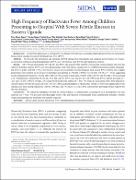| dc.description.abstract | Background. In the Fluid Expansion as a Supportive Treatment (FEAST) trial, an unexpectedly high proportion of participants
from eastern Uganda presented with blackwater fever (BWF).
Methods. We describe the prevalence and outcome of BWF among trial participants and compare the prevalence of 3 malaria-
protective red blood cell polymorphisms in BWF cases vs both trial (non-BWF) and population controls.
Results. Of 3170 trial participants, 394 (12.4%) had BWF. The majority (318 [81.0%]) presented in eastern Uganda and were the
subjects of further analysis. BWF cases typically presented with both clinical jaundice (254/318 [80%]) and severe anemia (hemoglobin
level <5 g/dL) (238/310 [77%]). Plasmodium falciparum parasitemia was less frequent than in non-BWF controls, but a higher
proportion were positive for P. falciparum histidine rich protein 2 (192/246 [78.0%]) vs 811/1154 [70.3%]; P = .014), suggesting
recent antimalarial treatment. Overall, 282 of 318 (88.7%) received transfusions, with 94 of 282 (33.3%) and 9 of 282 (3.4%) receiving
2 or 3 transfusions, respectively. By day 28, 39 of 318 (12.3%) BWF cases and 154 of 1554 (9.9%) non-BWF controls had died (P =
.21), and 7 of 255 (3.0%) vs 13/1212 (1%), respectively, had severe anemia (P = .036). We found no association with G6PD deficiency.
The prevalence of both the sickle cell trait (10/218 [4.6%]) and homozygous α+thalassemia (8/216 [3.7%]) were significantly lower
among cases than among population controls (334/2123 [15.7%] and 141/2114 [6.6%], respectively), providing further support for
the role of malaria.
Conclusions. We report the emergence of BWF in eastern Uganda, a condition that, according to local investigators, was rare
until the last 7 years. We speculate that this might relate to the introduction of artemisinin-based combination therapies. Further
studies investigating this possibility are urgently required. | en_US |

